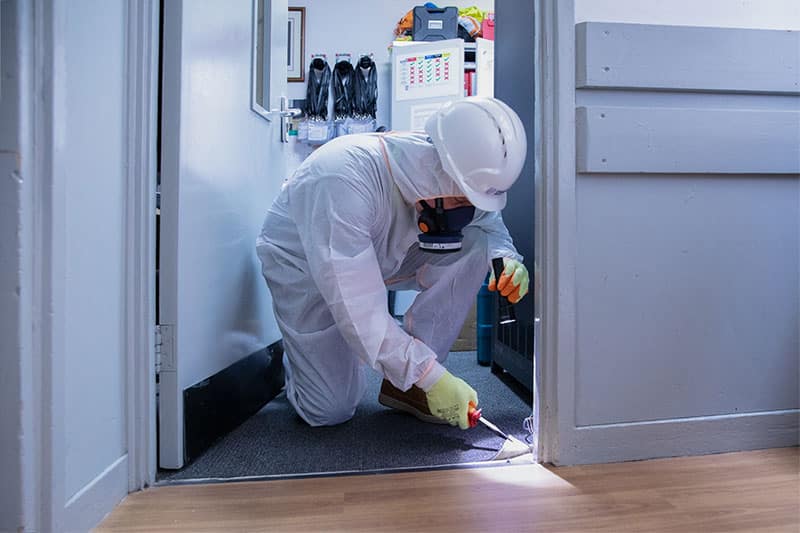Why are asbestos surveys important for safe and effective home retrofits?
Home retrofitting projects in the UK are significant for a number of reasons. They can improve your home’s energy efficiency with modern insulation and windows that reduce energy consumption. You can decrease your carbon footprint with upgraded heating and cooling systems that have lower greenhouse gas emissions. Your property value may also increase, as energy-efficient residences are more appealing to buyers.
However, older homes pose unique challenges when it comes to asbestos management.
It can be difficult to locate asbestos-containing materials (ACMs), as they’re commonly hidden within the structure, such as in floor tiles, insulation and pipe coverings. Only trained, qualified professionals will be able to locate and inspect these types of ACMs.
Additionally, older homes may not have accurate building records, if you’re able to find the building records at all. Since asbestos wasn’t always a known toxin, there wasn’t a need to notate when it was used in construction.
In this article, we’ll explain why asbestos surveys are important for safe, effective retrofitting projects in residences.
What is an asbestos survey?
An asbestos survey, which should only be conducted by a professional, is a methodical inspection of a home to find ACMs and determine their condition.
Since asbestos is only dangerous when fibres become airborne, which happens when the ACM is disturbed or damaged in some way, the condition of the material tells you its risk level. High-risk asbestos needs to be dealt with, but low-risk ACMs may be better off left alone.
What are the types of asbestos surveys?
There are two main types of asbestos surveys. Let’s go over them.
Management surveys
The purpose of this type of asbestos survey is to ensure that the ACMs are properly managed during regular use of the building. Typically, only minor work and disturbance are needed to conduct the survey.
Refurbishment and demolition surveys
This type of survey must be carried out before refurbishment or demolition work can take place. The survey will identify the ACMs that could be affected by the work and should, therefore, be dealt with before the project begins.
This type of survey is much more intrusive than a basic management survey. It’s common for the inspection to require the destruction of the work area to locate and identify ACMs.
Why is asbestos a concern during home retrofits?
Asbestos was commonly used in building materials for a number of reasons. Due to the strength of asbestos fibres and their resistance to heat, the mineral made an excellent insulator and fire retardant. It was also readily available and inexpensive, making it a go-to material for construction projects.
There are several common areas where asbestos can be found in homes, including:
- Cement
- Flooring
- Paint
- Patching compounds
- Pipe coating
- Roofing
- Siding shingles
- Textured paint
- Walls
Like with any major home project, retrofitting has the potential to damage ACMs, especially if you don’t know they’re present. This can release dangerous fibres into the air that go undetected. When inhaled, the fibres can stick to the lungs and cause respiratory trouble and life-threatening diseases in the future.
How do asbestos surveys enhance safety during retrofits?
Before work begins, an asbestos survey will identify where ACMs are located. This makes it possible for workers to plan on encapsulating or removing asbestos products that are directly in their work area. It can also alert workers to areas that contain asbestos outside of the work area that should be avoided to prevent damage.
If an ACM is disturbed without the proper measures in place, it can cause asbestos fibres to become airborne. Since those fibres are microscopic and don’t have a smell or taste, they can be inhaled or swallowed without the person realising it.
An asbestos survey can prevent these types of exposure incidents by finding where ACMs are located and noting their current state.
Asbestos professionals will know how to properly handle, encapsulate and remove ACMs so they don’t pose a problem during a retrofitting project. Asbestos must also be removed from the premises and disposed of carefully, following specific guidelines. This prevents the spreading of fibres around the home, as well as contamination of soil or water at the disposal site.
What are the legal requirements for asbestos surveys in the UK?
The Control of Regulations 2012 (CAR 2012) lays out the regulatory requirements for asbestos management in the United Kingdom. Regulation 4 covers asbestos surveys, which are not exactly mandatory but are a suggested and often-needed step for properly managing asbestos on any type of property.
The homeowner should have a survey conducted by a professional before any work on the home takes place, especially demolition and retrofitting work. Unless the building was constructed after 2000 or there’s evidence that asbestos no longer exists on the property, an asbestos survey is crucial for protecting everyone’s safety.
The asbestos survey will produce a report that includes details about the site, the survey, findings, assessment results and suggested actions to take moving forward.
How is an asbestos survey conducted?
There are multiple steps to conducting a proper asbestos survey. Here’s what the process includes:
- Planning and Prep: During this stage, the asbestos professional will define the scope of the survey based on the retrofitting project you have planned. Building records will be reviewed as well to find information about existing ACMs.
- Risk Assessment: A health and safety plan will be developed to protect the surveyors and home occupants while the survey is being conducted. Those within the home will be informed of the survey schedule and told which safety precautions to take.
- Initial Inspection: A walk-through and visual inspection can identify possible areas where ACMs might be, as well as any ACMs that are visible at the time.
- Sampling: The surveyor will collect samples from the suspected ACMs. Special techniques are used to minimise the risk of contamination.
- Analysis: An accredited lab will analyse the samples using specialised equipment and techniques that can detect the presence, type and concentration of asbestos in a material.
- Detailed Inspection: When a retrofitting project is planned, the inspection will be intrusive in order to access hidden areas.
- Survey Report: The asbestos survey report will be prepared and shared with all relevant parties.
It’s important that you hire a qualified, accredited asbestos surveyor. Inspecting, sampling and analysing the asbestos on the property is a crucial part of deciding what to do before the retrofitting project begins. Without proper planning, you could put workers, your family and yourself in a dangerous position.
How do asbestos surveys impact project planning and costs?
Since surveys are an essential step of the process when retrofitting your home, the cost of the survey should be added to the project timeline and budget.
There are several factors that will impact the cost of asbestos removal before your retrofitting project can take place, including the following:
- How extensive the asbestos contamination is
- The types of ACMs that have to be removed and their conditions
- How easy it is to access the ACMs
- Legally required permits, inspections, and disposal methods
In general, the more extensive the asbestos contamination, the higher the cost will be. Also, encapsulation often costs less than asbestos removal.
Additional costs you may incur include those for inspection, testing, permits, decontamination, cleaning, and temporarily relocating while work takes place.
The earlier you detect asbestos, especially if ACMs are still in good condition, the quicker the encapsulation or removal process will be. Also, the less complex the asbestos project is, the less it will cost. By waiting too long, you could have a lengthy and expensive process ahead of you, along with unexpected expenses that arise.
What are the long-term benefits of conducting asbestos surveys?
If you’re still wondering whether or not an asbestos survey is necessary, consider these benefits:
- You’ll protect the health of the workers as well as your home’s occupants.
- By upgrading your home, you can increase its property value.
- Complying with safety standards means you won’t face fees or other penalties for improper asbestos management.
- Dealing with an asbestos issue now means you’ll reduce liability and avoid future asbestos management costs.
Having an asbestos survey done isn’t just a simple suggestion — it’s a necessity if you want to protect the health of yourself, your family, other home occupants, and the workers you’ve hired.
Final thoughts about asbestos surveys for home retrofitting projects
Asbestos exposure is truly a life-or-death matter. It’s important that everyone involved in the home renovation job is transparent with one another and addresses any issues or concerns right away.
Homeowners and the contractors hired for the retrofit job must have clear communication. Additionally, they’ll have to coordinate schedules to ensure the asbestos remediation projects are completed before any other work begins.
Asbestos fibres are deadly, and failing to take the proper precautions before a renovation project can have disastrous consequences.
If you need to discuss asbestos removal before your home renovation project, contact the experts at Oracle Solutions today.

Written by Brendan Coleman
Brendan Coleman, with decades of experience in the asbestos industry, is a dedicated Quality Manager. Certified as a surveyor and analyst, he is adept in operations and quality management with a keen focus on HSE compliance. His expertise is pivotal in maintaining high safety and efficiency standards. Brendan ensures our UKAS accreditation requirements are consistently met and exceeded, upholding stringent standards in asbestos remediation. His commitment to enhancing quality and customer satisfaction makes him an essential advisor in asbestos management.


